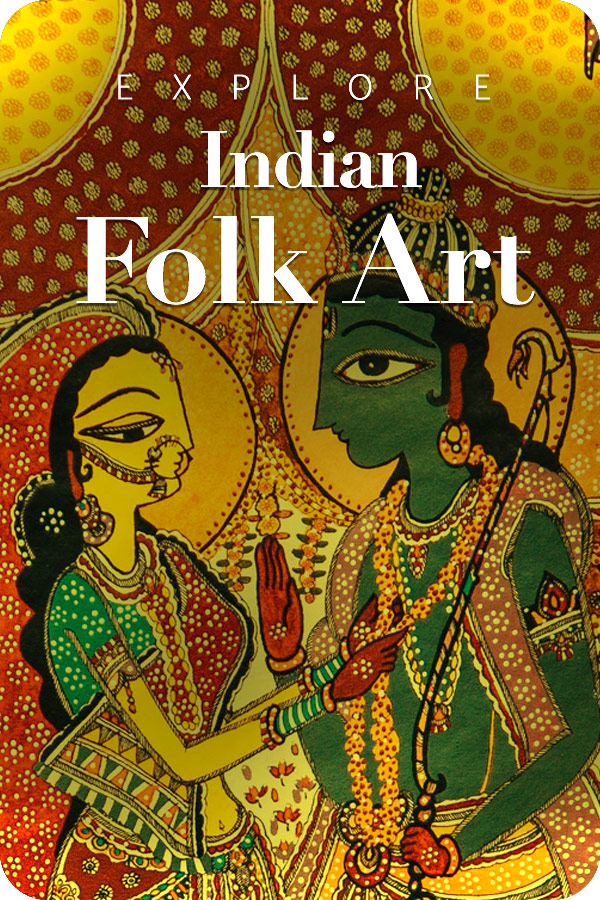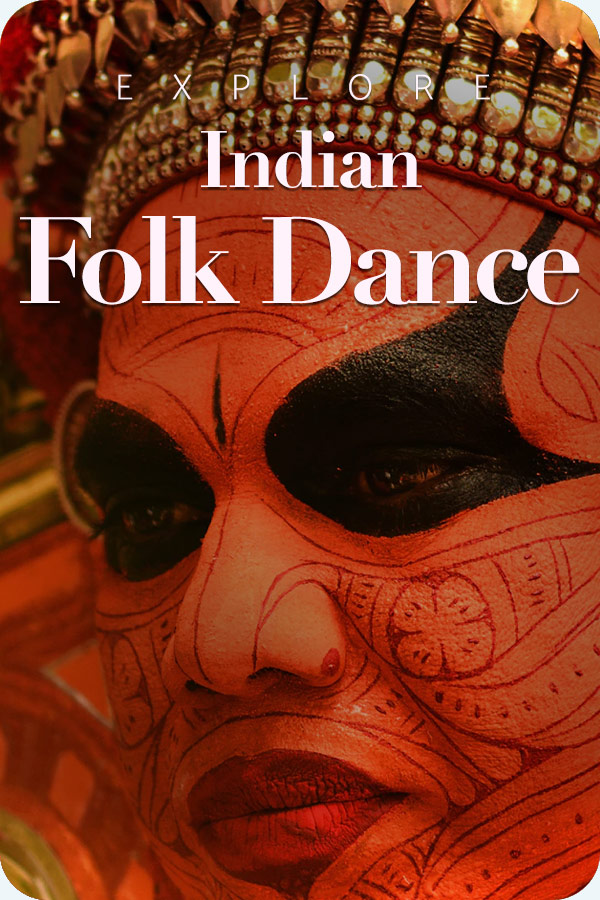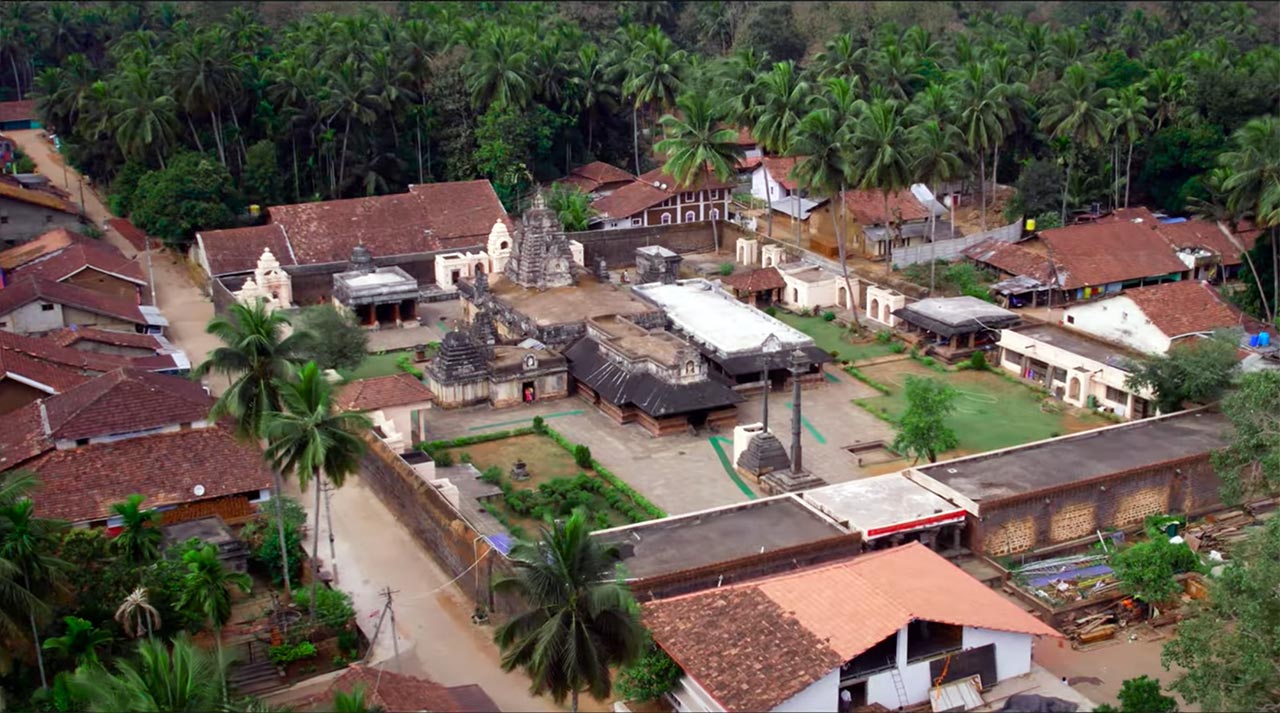
When you think of Karnataka, chances are Banavasi may not cross your mind. A small town situated near Sirsi, most people often miss its historical and cultural significance. But Banavasi is one of the oldest towns of the state, estimated to be in existence since 4000 BC. It is called ‘Vanavasaka’ in the Mahabharata, however, it came to prominence during the rule of the Kadamba dynasty. It was the capital of the kingdom and hence also owns the distinction of being the first capital of ancient Karnataka.
Banavasi Location and History

ಆರಂಕುಸವಿಟ್ಟೊಡಂ ನೆನೆವುದೆನ್ನ ಮನಂ ಬನವಾಸಿ ದೇಶಮಂ – ಆದಿ ಕವಿ ಪಂಪ
“Amidst the pain of a lance, his heart still beats for Banaasi, as if it were the only solace”. Above line is derived from Aadi Kavi Pampa’s “Papma Bharata” written during 10th century which explains the poets love for Banavasi.
Banavasi, located on the banks of River Varadha is 24 km from Sirsi and can be reached while driving on SH 77. Local buses ply regularly from Sirsi to Banavasi. Sirsi is well connected to Bengaluru through public transport. Banavasi is 100 km from the district center, Karwar and around 350 km from Bengaluru. Haveri, 70 km away is the nearest railway station.
Ruled by the Kadamba dynasty from the 4th to 6th century AD, the town is tucked in the beautiful Western Ghats. However, Banavasi exudes an aura of old-world charm and is a divine abode of some of the most ancient temples of south India. The Madhukeshwara Temple is the main religious hub, manifesting the intricate and detailed sculpting and architecture of earlier times. Besides, the calming natural beauty, rustic ambiance and culture of the town, make it an interesting and unique destination.
List of Banavasi Attractions
Though Madhukeshwara Temple is the main attraction of Banavasi, Jain and Buddhists religious temples are also found here. Besides, the natural landscape also offers some great tourist spots to visit.
| Attractions near Banavasi | Details |
|---|---|
| Madhukeshwara Temple | A 9th-century Shiva temple with a honey-colored lingam, 7-feet Nandi bull, and stunning stone pillars. Famous for its historical and architectural significance. |
| Pampa Vana | A forest dedicated to Adikavi Pampa, Karnataka’s first poet. The temple here is believed to be the original site of the Madhukeshwara temple. |
| Gudnapur | An archaeological site 5 km from Banavasi with a pillar detailing the origins of the Kadamba dynasty and a temple built by King Ravivarma. |
| Sahasralinga | A unique site 15 km from Banavasi across the River Shalmala, featuring hundreds of Shiv lingas carved into rocks, offering a picturesque and serene experience. |
| Gudavi Bird Sanctuary | A 25 km drive from Banavasi, home to over 190 bird species, including migratory birds that visit in winter. |
| Unchalli Waterfalls | Located 35 km from Banavasi, these waterfalls can be accessed by a thrilling trek through steep paths. |
| Treks & Trails | Explore Banavasi’s surroundings through various trekking routes such as the Banavasi to Yana Trail and Kadamba Trails. |
Madhukeshwara Temple
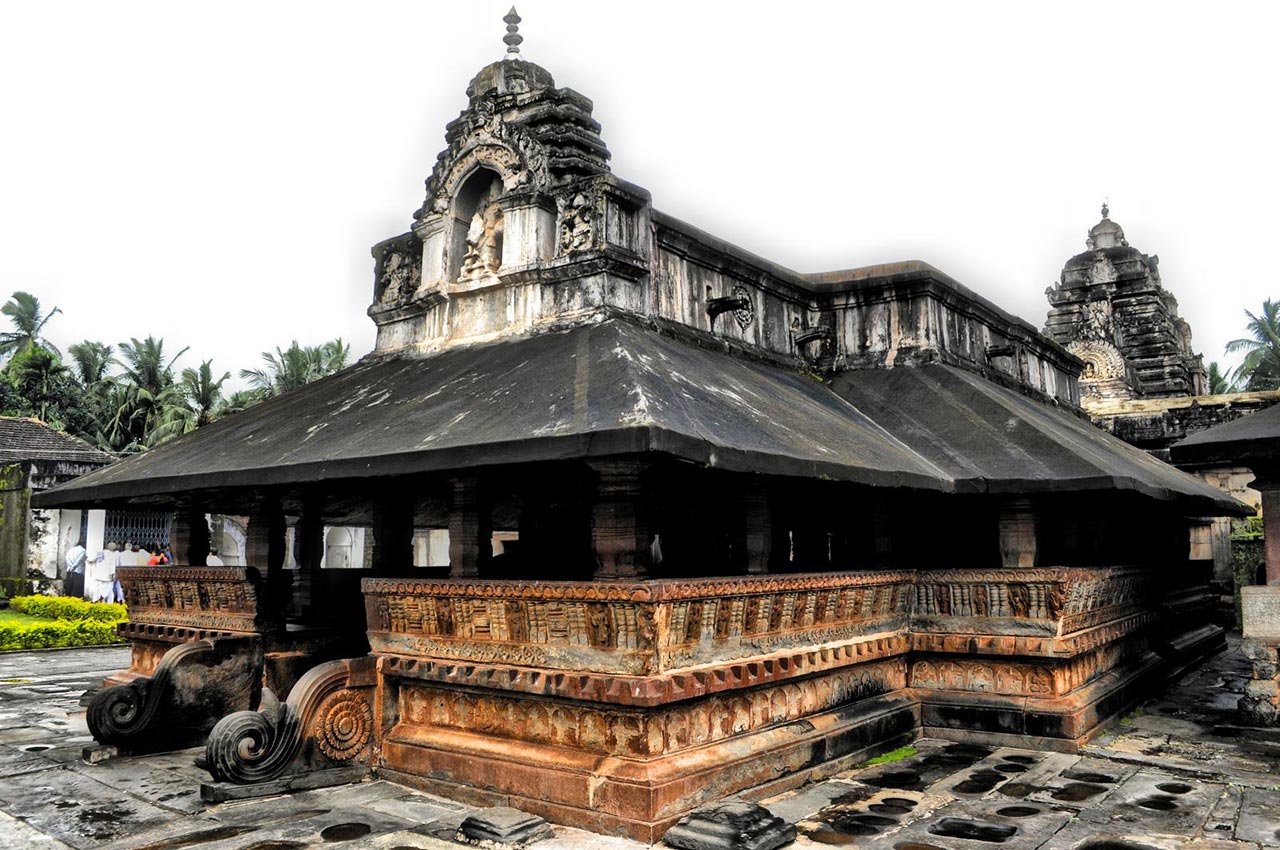
Madhukeshwara Temple is the main attraction of Banavasi. Dedicated to Lord Shiva this temple was built in the 9th century CE. Its most fascinating features are the honey colored lingam, the 7 feet tall Nandi bull, the stunning stone pillars and more. In fact, the color of the lingam is what gives the temple its name. The uniqueness of the temple lies in not only the larger structure, but also in the little details. For instance, the statue of the Nandi Bull has its head tilted where one eye is looking at the garba griha where the lingam is located. The other eye seems to be looking at the Parvati Temple, situated adjacent to Madhukeshwara Temple.
The temple also houses the statue of the Adi-Madhava which several people believe was the original or first deity of the temple. Till date devotees worship this statue first before heading into the Shiva lingam. The Madhukeshwara temple was commissioned by Mayura Sharma, a Kadamba King. However, several renovations, additions and extensions have been made to the temple complex over the years, during the Chola, Chalukyas, Hoysalas, Sonda dynasties. The navranga, polished pillars, stone cot in the temple courtyard, sandalwood chariot and half Narasimha and Ganapati statues are features that might have been added in the later years.
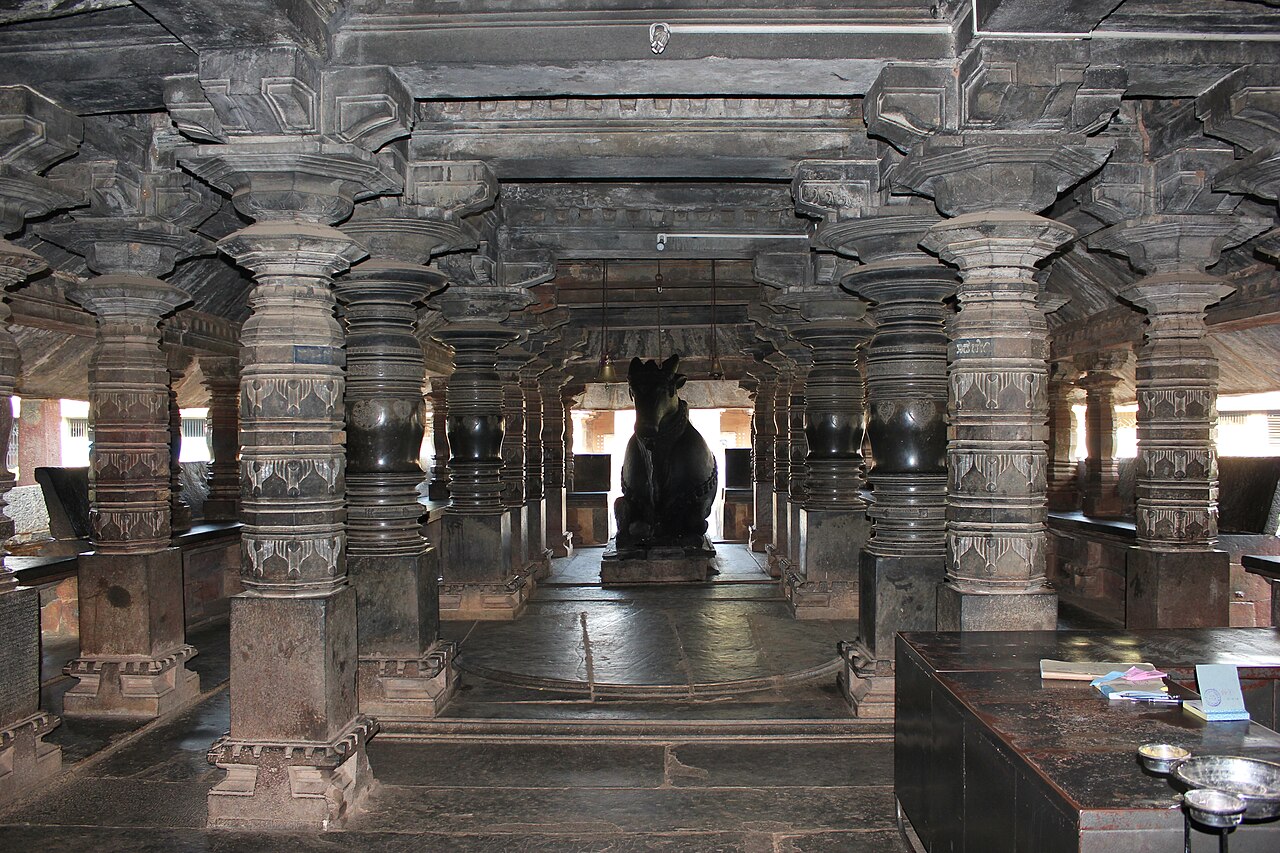
The kalyana mantapa or triloka mantapa is architecturally splendid. The other mantapas or mandapas worth seeing include the Nritya Mandapa, the Darshana Mandapa and the Astana Mandapa. The sandalwood chariot or rakta chandana is believed to have been donated by Ramachandra Nayak in the 17th century. It till date is one of the tallest temple chariots in Karnataka.
During the Kadambotsava Festival, several devotees make their way to the temple.
Pampa Vana
Adikavi Pampa is considered as the first Kannada poet in Karnataka. He is credited with writing epics, such as Vikramarjuna Vijaya, Adi Purana and Pampa Bharata. This renowned poet was the court poet of Vemulavada Chalukya who wrote his most famous works in Banavasi. The Pampa Vana is a forest dedicated to the great poet. Inside this small forested area, that also houses a children’s park, there is another ancient temple called Adi Madhukeshwara. Though there is a single lingam inside the temple, devotees believe that the Madhukeshwara temple was first built here. However, it was shifted to its current location later. There is a navranga, shikhara and pillars in different architectural styles that can be seen in this temple. It is local belief that during drought or low rainfall, devotees pray here and within a week they are blessed with rainfall.
Gudnapur
5 km from the town of Banavasi is the village of Gudnapur. Gudnapur is an archeological site that once held the origins of the Kadamba dynasty. There is a pillar also called stambha shasana, that stands here with inscriptions that bring to light the genealogy and origins of the dynasty. Built by King Ravivarma, the pillar also bears documentation about the temple, harem, and dancing halls that once stood here. However, besides the pillar, there are a few Jain Tirthankar statues and a large lake or tank constructed by the king for agriculture. The Bangareshwar Temple is located in the middle of this water body.
Sahasralinga

15 km from Banavasi, one can find an interesting site across the River Shalmala. There are hundreds of Shiv lingas, beautifully carved into the rocks on the river. These stunning carvings might have been done by different kings across the years as acts of devotion. The captivating carvings along with the serenity of the river and surroundings, makes it a popular attraction of Banavasi. This is a great spot for photography too.
Other Tourist Sites near Banavasi
Besides temples and religious structures, Banavasi also has natural attractions.
Gudavi Bird Sanctuary
25 km from Banavasi, lies the quiet Gudavi Bird Sanctuary. The forest cover and wetlands provide the perfect shelters for birds of different species. Around 190 avian species are found here including egrets, cormorants, herons and more. Migratory birds also come here in large numbers during the winters.
Unchalli Waterfalls
Also known as the Lushington Falls, the Unchalli waterfalls are 35 km from Banavasi. The fall can be accessed after an adventurous trek that trails on steep and narrow pathways.
Treks & Trails
Travelers can embark on thrilling trekking routes to explore the surrounding areas of Banavasi. The Banavasi Trail starts from Madhukeshwara Temple to Gudavi Bird Sanctuary. En route watch the local artisans at work, visit Pampa Vana and the pineapple farms.
The Banavasi to Yana Trail takes travelers to the splendid Yana caves. They can explore the Unchalli Falls, Sahasra Linga and Marikhamba Temple.
The Kadamba Trails takes visitors on a cultural and historical route of the dynasty while to enjoy the rushing waters the Jof Falls Trail is popular.
Agriculture and Culture

Banavasi is essentially an agricultural town. The famous pineapple farms steal the limelight. However, there are many other crops grown here including bananas, areca nuts, rice and more. Also, an art gallery called Varnaloka in the town displays exquisite arts and crafts of the region. One can buy sandalwood creations, Yakshagana masks, baskets, sculptors, carved items, temple requirements etc.
Autumn, winter and spring are the best months to visit Banavasi. Besides, there are a few eco-friendly guesthouses and places of stay. The ‘khanavalis’ are little eateries that serve authentic delicious local cuisines, which have a generous serving of chutneys and powders.
Takeaway
Banavasi is not the fast-paced tourist destination that is packed with world-class tourist attractions to visit. On the other hand, it is steeped in natural beauty, biodiversity and a rich history and culture. For a bit of quiet, peace and soulful endeavours, Banavasi is a uniquely good choice.




